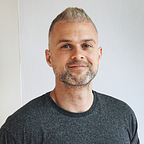‘Here to there’
How does a creative agency grow and develop
At Play we pride ourselves on our ability to deliver world class products and services. These are created using our methodology which is the backbone of our design process. However, this week we spent sometime as a group using tools like ‘Here to there” and “How might we’s” internally to further develop this prized asset. Every time we re-embark on designing our process we find ourselves asking the same questions, why and how?
Firstly the how. How does a creative and innovative company like Play develop their methodology / philosophy to benefit the company and our clients? The word ‘philosophy’ sends shivers down my spine thanks to the one and only Louis Van Gaal.
Was the genius getting old?
As a Manchester United fan, it pains me to think of his ‘philosophy’. Yet it was a timely reminder for the Play team. Even the best philosophy’s can be misguided and out of place. Having begun to tinker with the philosophy just as Van Gaal did, we risk no longer being sure what it entails.
This then poses the question why? Why do we need to develop? Whats wrong with doing what we currently do if it is successful in the first place? Is it all about keeping ahead of the competition, which admittedly seems to be growing by the day locally, nationally and internationally. Or is it just good housekeeping, making sure we don’t forget about things like version control etc?
In Mr Gaal’s situation, many began to feel that the ‘fundamentalist’ had begun to question himself — and the result was not an unqualified success’.
Do we risk going down the same path if we question and ‘tinker’ with something that currently works?
In the beginning
Play is essentially a young company. Having only been trading for a few years and starting out with a small team, we‘ve had the opportunity to work with some fantastic companies on some really interesting projects. This in part is due to the success of our highly refined methodology.
This began in earnest in 2012 with the public release of GV in 2012. This led us to take it upon ourselves to practice and perfect the sprint process. As successful as this first demo sprint was, we were quick to recognise its faults and the mistakes that we made along the way. Obviously we couldn’t just use this new methodology with the next available client. So instead we practiced, developed and tested our own take on the GV sprint process over the next few years. Each time we learnt from the previous project and tweaked things for the next.
From here, we began to realise it needed refining and developing on a project dependant basis. For the next four years we worked hard to develop our own, tailored methodology albeit on a adhoc, organic basis. As a small company it is difficult to spend time (and money) on your own processes and philosophies. We have made many mistakes, but mistakes are good, we learn from each one and use it to develop further… something LVG should have done.
So why do we now structure our design process as opposed to the organic manner in which we have grown so far? To be fair, it’s not always organic, as the company grew and the methodology progressed we felt it needed some structure. Without structure we risk falling behind in terms of development, and in paving the way for creative consultancies. We believe in our ability and don’t shy away from wanting to be the best at what we do. Yet to do that you need to be one step ahead of the crowd from an ability and skills perspective. This comes from a refined, developed and ‘ahead of the curve’ methodology (as well as the best team in the game).
Play is not just essential for kids
As our name suggests, our process for building on the current philosophy / methodology has to be fun and creative. Why?
This style of development can be clearly seen in the outputs of our methodology, with the production of a Playbook and Playcards. These are essentially the toolkits of our process, containing specific sections of tools that belong to a phase of the methodology.
With 102 tools and counting we have even begun to use them in the methodology development workshops, like the one we ran today (hence the title of this post). ‘Here to there’ is a simple, creative process for imagining where we want to be in the future. In this case we used the tool to individually visualise where we wanted the Play methodology to be in the next 5, 10, 15 years. This was a great way to start the day, and set the team up with a shared vision for the rest of the workshop.
In summary
By holding these monthly development workshops, or ‘away-days’ as we call them, we allow ourselves the time and space to step back and look at the bigger picture. The bigger picture being what does the future of Play look like. This structure stops us from randomly tinkering with our process in a muddled manner that only results in the team questioning themselves, much like Mr Van Gaal in his final managerial years.
Keep following us to find out more about of methodology and how you will soon be able to get your hands on the Playbook and Playcards.
If you fancy a chat about this post then email us hello@aplaything.com or check out our website www.aplaything.com
